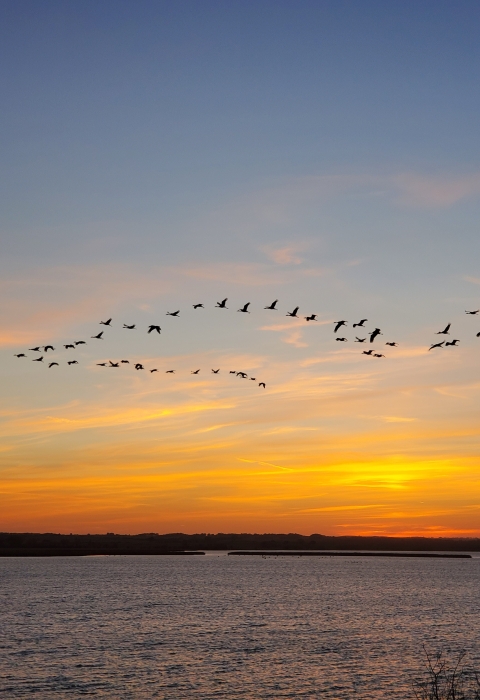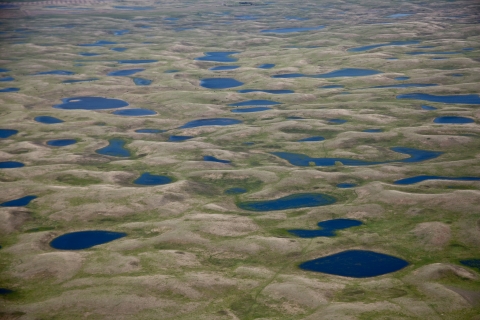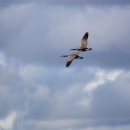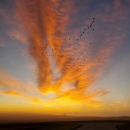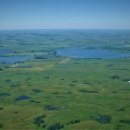About Us
Enjoy the rolling nature of the landscape on the Missouri Coteau and the Missouri River Slope, where precipitation in the area averages around 16 inches annually. Approximately 70% of the land in the three-county area remains virgin sod - native mixed-grass prairie. The wetlands found in the northeastern portion of the Wetland Management District are classic prairie potholes of various sizes and types that are prime duck production habitat. Soils in this area are generally deep and quite productive. Many of the wetlands on Missouri River Slope portion of the wetland management district wetland management district
A wetland management district is a U.S. Fish and Wildlife Service office that manages waterfowl production areas in one or more counties. Waterfowl production areas are small natural wetlands and grasslands that provide breeding, resting and nesting habitat for waterfowl, shorebirds, grassland birds and other wildlife. The Fish and Wildlife Service acquires waterfowl production areas under the authority of the Migratory Bird Hunting and Conservation Stamp Act, primarily using funds from the sale of Federal Duck Stamps. The Refuge System’s 38 wetland management districts comprise thousands of waterfowl production areas – almost all in the Prairie Pothole Region of the Northern Great Plains.
Learn more about wetland management district are large semi-permanent and permanent alkali wetlands.
The Long Lake Wetland Management District habitats are comprised of waterfowl production areas, satellite refuges, wildlife development areas, wetland and grassland easements, and private lands agreements. Waterfowl production areas are fee title lands purchased under authority of the Small Wetlands Acquisition Program, funded with Duck Stamp dollars.
The goals for the Wetland Management District are listed below:
- Conserve, restore, and enhance federally listed endangered species and the habitats upon which they depend.
- Provide life requirements of waterfowl and other migratory birds occurring naturally in this portion of the Prairie Pothole Region.
- Provide life requirements of resident wildlife species.
- Provide a wide range of opportunities for compatible wildlife/wetlands-oriented recreation, interpretation, and education.
- Foster conditions under which prehistoric and historic resources can exist in harmony with the U.S. Fish and Wildlife Service mission.
- Preserve and enhance the overall environmental quality, wild character, and natural beauty of the Long Lake Wetland Management District.
Our Mission
Each unit of the National Wildlife Refuge System is established to serve a statutory purpose that targets the conservation of native species dependent on its lands and waters. All activities on those acres are reviewed for compatibility with this statutory purpose.
The Long Lake Wetland Management District was established “…to assure the long-term viability of the breeding waterfowl population and production through the acquisition and management of waterfowl production areas, while considering the needs of other migratory birds, threatened and endangered species, and other wildlife.”
Long Lake waterfowl production areas and all conservation easements provide a network of wetland and grassland habitats that preserve the integrity of the historic and vital nesting and breeding grounds of North America’s migratory waterfowl. The management and conservation efforts support populations of nesting ducks and geese at, or above, historic levels. New and expanded habitats are provided for trust species including nongame migratory birds, threatened and endangered species, and resident wildlife. The public recognizes these wetlands and uplands as a beneficial and important component of a diverse, healthy, and productive prairie landscape.
Our History
The Long Lake Wetland Management District was started as part of the Small Wetlands Acquisition Program in the 1950s to save wetlands from various threats, particularly drainage. Due to the passing of Public Law 85-585 in August 1958 which amended the Migratory Bird Hunting and Conservation Stamp Act of 1934, it allowed for the acquisition of waterfowl production areas and easements.
Easements are comprised of wetland easements and grassland easements. In the late 1950's, concern over rampant U.S. Department of Agriculture subsidized wetland drainage catalyzed the conservation community. The program to save the wetlands was authorized by Congress on August 1, 1958. It is financed by receipts from the sale of Migratory Bird Hunting and Conservation Stamps, commonly known as Duck Stamps. Hunters and other conservation-minded people throughout the nation are supporting this project when they purchase these stamps.
The grassland easement, often used in combination with a wetland easement, protects the entire prairie pothole community. The U.S. Fish and Wildlife Service first offered this combination of easements in 1991. Since then, it has been used successfully to protect the grass uplands around wetlands previously protected by wetland easements, and it is now used concurrently with wetland easements.
Other Facilities in this Complex
The Long Lake Wetland Management District is an array of private and fee-title land that is managed out of the Long Lake National Wildlife Refuge Headquarters.
